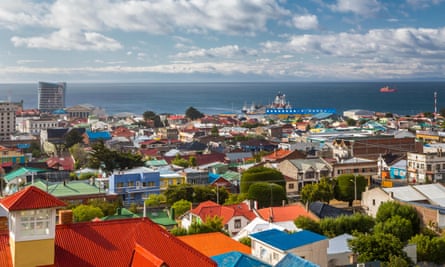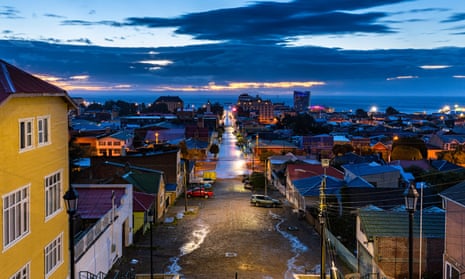When Robert Scott’s frozen remains were recovered 105 years ago this week, Antarctic exploration was a European-only affair. Now it’s a bustling global concern, poised to open up even more as the ice caps recede. Chile’s southernmost city, Punta Arenas, a wind-bitten port of nearly 130,000 on the Strait of Magellan, is jostling for position as gateway city to the Antarctic.
It welcomed Scott himself in July 1904 when the Englishman sent 400 letters announcing the safe return of his Discovery expedition at the post office on Plaza Muñoz Gamero. One of his officers pronounced the city a “wretched-looking place”. Not so much now, with Punta Arenas hosting the national Antarctic programmes of 20 countries and becoming one of Chile’s fastest-growing cities in the process.
This article includes content provided by Instagram. We ask for your permission before anything is loaded, as they may be using cookies and other technologies. To view this content, click 'Allow and continue'.
South pole position
Compared to fellow gateway cities Christchurch, New Zealand, and Hobart, Australia, which focus more on transit to the deep Antarctic, Punta Arenas is the jumping-off point for international biology expeditions to the Antarctic peninsula. It lies on one side of the 660km Drake Passage crossing, the shortest hop to the giant spur of the continent where 80% of its biodiversity is concentrated. Since the Chilean Antarctic Institute (INACH) moved to Punta Arenas in 2004, the country has shifted from a “geopolitical” stance – trying to assert its sovereignty over the ice to the south – to a “cooperative, globally orientated” one, says Marcelo Leppe, an INACH paleobiologist.
Chile still fosters a psychological claim to the territory with cultural drives such as Antarctic school fairs. But its growing commitment to collaboration will soon be visible on the Punta Arenas waterfront in the shape of a showcase $50m International Antarctic Centre. Scheduled to open in 2021, the 15,000 sq metre complex will function as an international research hub, a logistics base for southbound expeditions and a general-purpose museum. Antarctic tourism has traditionally been the prerogative of Punta Arenas’ neighbouring Argentinian city Ushuaia. But the planned expansion of Punta Arenas’ airport, with more civilian flights, could reduce the attractiveness of its sister city’s cruise ships. “Most people don’t enjoy crossing the Drake Passage by sea,” says Leppe. “It’s not an experience I want to repeat again.”

Punta Arenas in numbers
1494 Year the Treaty of Tordesillas was signed, which Chile later used to justify its Antarctic claims
8,000 Citizens who lined the docks in September 1916 to greet the return of the Chilean navy mission that rescued the survivors of Ernest Shackleton’s Endurance
18,000 Barrels of Chilean oil produced per day in 2012. A significant proportion of the country’s reserves are processed in Punta Arenas; peak production was in 1982, with 55,000 barrels a day
0.9% Unemployment recorded in Punta Arenas’ Magallanes region in April-June this year, a historic low
This article includes content provided by Instagram. We ask for your permission before anything is loaded, as they may be using cookies and other technologies. To view this content, click 'Allow and continue'.
History in 100 words
In 1848, Chile set up a penal colony that grew into Punta Arenas – positioned so that the fledging state could control the Strait of Magellan. Swelled by European immigrants, it rode the 19th-century Patagonian sheep-farming boom to become a wool-production centre – perfectly placed on maritime export routes. That, and local coal reserves, funded the European-style splendour of the city’s mansions. It was renamed Magallanes from 1927 to 1938, but the Panama canal had robbed the strait of its importance. The slump was arrested with the 1945 discovery of oil, and now the Antarctic linkup.
Punta Arenas in sound and vision
What the city sends to Antarctica, it gets back in southerly winds that can gust up to 80mph. Get a feel for a Punta Arenas freshener here.
The 2011 documentary The Human Zoo is a sorrowful exposé of how Patagonia’s indigenous people were kidnapped by early European settlers and exhibited in cities thousands of miles away. Acclaimed film-maker Patricio Guzmán threaded their story into the Pinochet era for his 2015 film The Pearl Button.
Biggest urban risk
The discovery of the hole in the ozone layer over Antarctica in the mid-1980s had serious health implications for Punta Arenas. Cases of skin cancer reportedly rose by 65% between 1987 and 2000, and for one month in 2000 residents were warned not to go outside between 11am and 3pm unless it was absolutely necessary. The hole has shrunk in recent years, but the city’s behaviour has adapted for good. Scanning weather reports for UV ratings is mandatory, and so is judicious use of sunblock. “There’s a culture associated with the ozone hole here,” says Leppe, “Everybody uses protection.”
This article includes content provided by Instagram. We ask for your permission before anything is loaded, as they may be using cookies and other technologies. To view this content, click 'Allow and continue'.
Eco-fitting the city
The Chilean authorities and media watch Punta Arenas as a canary in the coalmine of climate change; 2017, for example, was the first time in a decade that the ski resorts in the nearby natural park were shut for the entire year due to a lack of snow. But, for a scientific hub, it lacks the digital infrastructure needed to relay the data that would give us a better understanding of global warming. Leppe cites the record Antarctic temperatures recorded in March 2015 and flooding in northern Chile days later, events he believes were interrelated. “We need to have a capacity of analysis with a speed that permits us to predict some of these very strange climate behaviours,” says Leppe. Hence the new Southern Fibre Optic link recently confirmed by the Chilean government. Punta Arenas will be a node on around 4,000km of fibre-optic infrastructure aiming to bring the southern Chile’s internet up to speed. With talk of further submarine links to New Zealand and China, it’s the next step in using its proximity to Antarctica to give the city global leverage.
This article includes content provided by Instagram. We ask for your permission before anything is loaded, as they may be using cookies and other technologies. To view this content, click 'Allow and continue'.
What’s next for the city?
An isolated settlement with close-knit immigrant spirit turned 21st-century global stopping point, Punta Arenas has a third, forgotten identity: its indigenous heritage. In 2006, there were only 15 full-blood members remaining of the region’s Kawésqar ethnic group remaining after heavy suppression under the Pinochet dictatorship. There has been a renewal of interest in their history, customs and trampled rights – highlighted in the documentaries mentioned above, as well as the work of activists, historians and artists. New social housing allocated to several of Patagonia’s indigenous groups is being completed on Manuel Rodriguez Street in the southern part of the city. Leppe sees it as a healthy evolution of Punta Arenas’ Eurocentric self-image: “The original settlers found a small Eden here, away from the wars. But they created their own war here. And after over 100 years, it’s time to reconcile these two parts of our history.” Rewriting the narrative of the city to incorporate the indigenous experience is also a vital part of its push into tourism, as continues to look for a sustainable future beyond oil.
Close zoom
This INACH guide walks you step-by-step through Punta Arenas’ intrepid past. For up-to-date news, there’s the Spanish-language El Magallanews.
Do you live in Punta Arenas? What key facts, figures and cultural highlights have we missed? Share your stories below
Follow Guardian Cities on Twitter, Facebook and Instagram to join the discussion, and explore our archive here

Comments (…)
Sign in or create your Guardian account to join the discussion